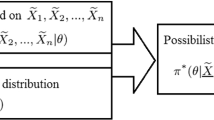Abstract
The “similar problem-similar solution” hypothesis underlying case-based reasoning is modelled in the framework of possibility theory and fuzzy sets. Thus, case-based prediction can be realized in the form of fuzzy set-based approximate reasoning. The inference process makes use of fuzzy rules. It is controlled by means of modifier functions acting on such rules and related similarity measures. Our approach also allows for the incorporation of domain-specific (expert) knowledge concerning the typicality (or exceptionality) of the cases at hand. It thus favors a view of case-based reasoning according to which the user interacts closely with the system in order to control the generalization beyond observed data. Our method is compared to instance-based learning and kernel-based density estimation. Loosely speaking, it adopts basic principles of these approaches and supplements them with the capability of combining knowledge and data in a flexible way.
Preview
Unable to display preview. Download preview PDF.
Similar content being viewed by others
References
A. Aamodt and E. Plaza. Case-based reasoning: Foundational issues, methodological variations, and system approaches. AI Communications, 7(1):39–59, 1994.
D. W. Aha, D. Kibler, and M. K. Albert. Instance-based learning algorithms. Machine Learning, 6(1):37–66, 1991.
C. M. Bishop. Neural Networks for Pattern Recognition. Clarendon Press, Oxford, 1995.
B.V. Dasarathy, editor. Nearest Neighbor (NN) Norms: NN Pattern Classification Techniques. IEEE Computer Society Press, Los Alamitos, California, 1991.
B.V. Dasarythy. Nosing around the neighborhood: A new system structure and classification rule for recognition in partially exposed environments. IEEE Transactions on Pattern Analysis and Machine Intelligence, PAMI-2(1):67–71, 1980.
T. Denoeux. A k-nearest neighbor classification rule based on Dempster-Shafer Theory. IEEE Trans. Systems, Man, and Cybernetics, 25(5):804–813, 1995.
D. Dubois, F. Esteva, P. Garcia, L. Godo, R. Lopez de Mantaras, and H. Prade. Fuzzy set modelling in case-based reasoning. Int. J. Intell. Syst., 13:345–373, 1998.
D. Dubois and H. Prade. The three semantics of fuzzy sets. Fuzzy Sets and Systems, 90(2):141–150, 1997.
S. A. Dudani. The distance-weighted k-nearest-neighbor rule. IEEE Transactions on Systems, Man, and Cybernetics, SMC-6(4):325–327, 1976.
M. E. Hellman. The nearest neighbor classification rule with a reject option. IEEE Transactions on Systems, Man, and Cybernetics, SSC-6:179–185, 1970.
E. Hüllermeier. Toward a probabilistic formalization of case-based inference. Proc. IJCAI-99, pages 248–253, 1999.
E. Hüllermeier, D. Dubois, and H. Prade. Knowledge-based extrapolation of cases: A possibilistic approach. In Proceedings IPMU-2000, 2000. To appear.
M. Jaczynski and B. Trousse. Fuzzy logic for the retrieval step of a case-based reasoner. In Proc. EWCBR-94, pages 313–321, 1994.
D. Kibler and D. W. Aha. Instance-based prediction of real-valued attributes. Computational Intelligence, 5:51–57, 1989.
P. Myllymäki and H. Tirri. Bayesian case-based reasoning with neural networks. Proc. IEEE Int. Conf. Neural Networks, pages 422–427, 1993.
E. Plaza, F. Esteva, P. Garcia, L. Godo, and R. Lopez de Mantaras. A logical approach to case-based reasoning using fuzzy similarity relations. Journal of Information Sciences, 106:105–122, 1998.
R.R. Yager. Case-based reasoning, fuzzy systems modelling and solution composition. Proc. ICCBP-97, pages 633–643, 1997.
L.A. Zadeh. A fuzzy-set theoretic interpretation of linguistic hedges. J. Cybernetics, 2(3):4–32, 1972.
Author information
Authors and Affiliations
Editor information
Editors and Affiliations
Rights and permissions
Copyright information
© 2000 Springer-Verlag Berlin Heidelberg
About this paper
Cite this paper
Dubois, D., Hüllermeier, E., Prade, H. (2000). Flexible Control of Case-Based Prediction in the Framework of Possibility Theory. In: Blanzieri, E., Portinale, L. (eds) Advances in Case-Based Reasoning. EWCBR 2000. Lecture Notes in Computer Science, vol 1898. Springer, Berlin, Heidelberg. https://doi.org/10.1007/3-540-44527-7_7
Download citation
DOI: https://doi.org/10.1007/3-540-44527-7_7
Published:
Publisher Name: Springer, Berlin, Heidelberg
Print ISBN: 978-3-540-67933-2
Online ISBN: 978-3-540-44527-2
eBook Packages: Springer Book Archive




